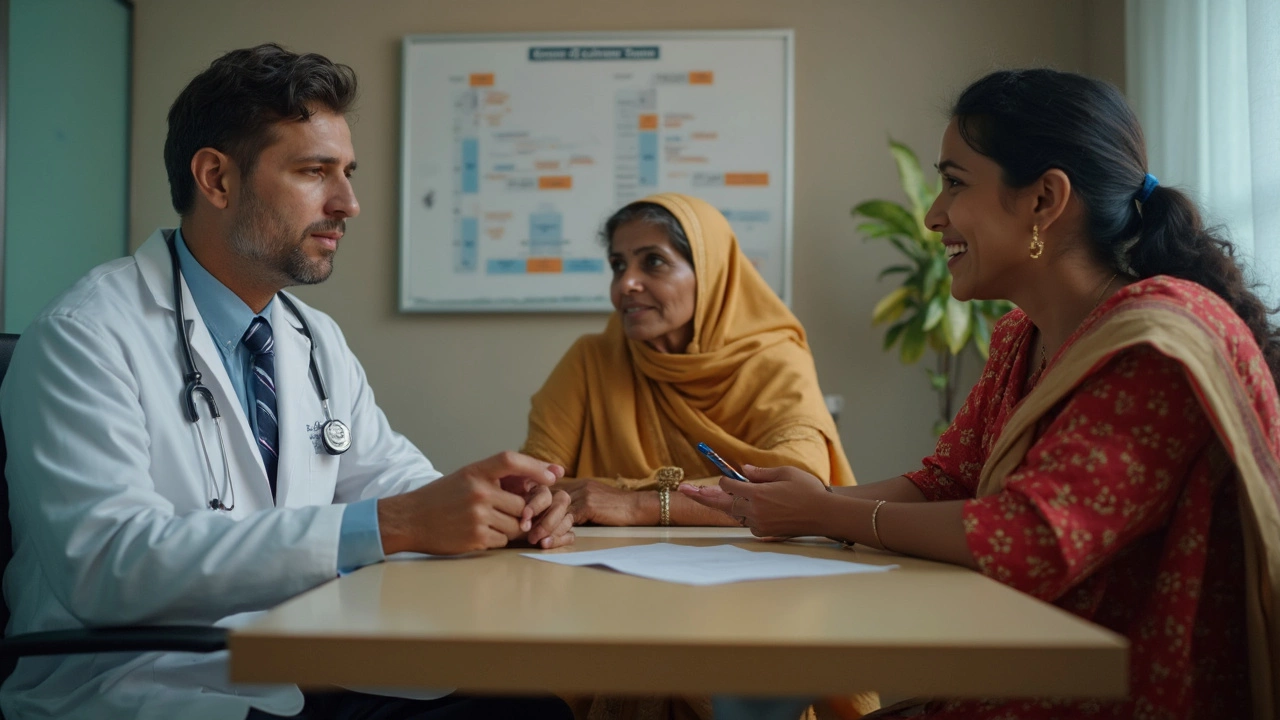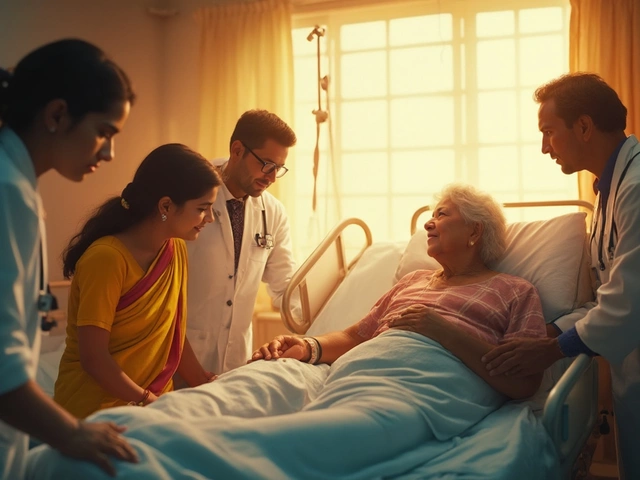
Stage 4 vs Stage 3 Cancer: What's Really Worse?
Stage 3 and stage 4 cancer sound terrifying, but what do these labels really mean? If you or someone you care about has just heard one of these words at the doctor’s office, you’re probably desperate for straight answers, not sugar-coated talk or endless medical mumbo jumbo.
Here’s the no-nonsense version: Stage 3 usually means the cancer is big or has spread to nearby tissues or lymph nodes, but it’s mostly stayed close to where it started. Stage 4 is when cancer has made the jump to other parts of the body—maybe the lungs, liver, bones, or brain. Once it spreads that far, the approach—and the outlook—shifts big time.
Why does this matter for treatment and survival? Well, the stage tells doctors what arsenal to use and gives people an idea of what to expect. Understanding the real differences helps you ask smarter questions and push for the support you need if you’re facing one of these diagnoses.
- Breaking Down the Stages: Stage 3 vs. Stage 4
- Why Staging Matters So Much
- How Treatment Plans Change
- Survival Rates and What They Actually Mean
- Tips for Navigating a Tough Diagnosis
Breaking Down the Stages: Stage 3 vs. Stage 4
Doctors don’t just use stage numbers to scare people; they label cancers this way to map out how far the disease has gone and what it’ll likely take to fight it. Here’s where the differences between stage 4 cancer and stage 3 cancer become clear.
Stage 3 cancer usually means the tumor is big or has spread into nearby areas. In many cancers, stage 3 also means cancer cells have moved into nearby lymph nodes—the little filters your body uses to trap bad stuff. But at this point, it’s still in the neighborhood. For a lot of cancers, stage 3 is sometimes still treatable with surgery, heavier chemo, or radiation, since the main fight is still close to home base.
Stage 4 is another story. When doctors say stage 4, they mean the cancer is metastatic—it’s taken off and landed somewhere completely different in the body. Think breast cancer winding up in the bones or lungs, or colon cancer turning up in the liver. Stage 4 almost always means the cancer can’t be cured with surgery alone, and treatment shifts to controlling symptoms, slowing the growth, or shrinking tumors as much as possible.
Not every cancer type uses the same rules. For example, with some blood cancers or rare cancers, doctors don’t talk about stages in the same way. But for the big ones—breast, lung, colon, prostate—stages 3 and 4 mean what you’ve just read: nearby versus spread-out.
Wondering how doctors figure out the stage? It’s usually a mix of scans, biopsies, and sometimes surgery. They look at:
- The size of the original tumor
- Whether it’s moved into local lymph nodes
- If cancer cells have traveled far from the original site (metastasized)
It isn’t just about numbers; it sets the whole playbook for how to attack and what to expect next.
Why Staging Matters So Much
Staging is basically cancer’s report card. It shows how far things have gotten, and that tells the doctors what to do next. If you just hear “cancer” without knowing the stage, it’s like knowing there’s a storm coming but having no clue if it’s a drizzle or a hurricane. That’s why getting the stage right sets up everything—treatment, side effects, even planning for work or family.
Here’s how it really plays out:
- Stage 4 cancer means the cancer has spread far, showing up in places far from the original spot. Stage 3 is mostly local but may have reached nearby lymph nodes.
- Treatment plans lean heavy on the stage. Stage 3 might mean surgery, chemo, radiation—or all three. Stage 4 usually pulls in more systemic treatments, like targeted therapy or immunotherapy, because surgery often can’t get it all.
- Doctors use stages to estimate survival odds and help guide tough conversations. Everyone’s outcome is different, but the stage gives people a roadmap.
To keep it clear, here’s how different stages usually stack up when it comes to cancer spread and what that means for treatment:
| Stage | Where Cancer Has Spread | Main Treatment Options |
|---|---|---|
| Stage 3 | Large tumor, may have spread to nearby nodes/tissues | Surgery, chemotherapy, radiation, sometimes targeted |
| Stage 4 | Spread to distant organs (e.g., lung, brain, bone) | Chemo, targeted therapy, immunotherapy, palliative care |
Doctors often use scans, blood tests, biopsies, and sometimes genetic testing to figure out the stage. Your precise plan will depend on the cancer type, exact stage, and your personal health. But knowing the stage right away helps everyone tackle the next steps in an organized way, instead of just guessing as they go.

How Treatment Plans Change
When doctors find stage 4 cancer, the main goal often shifts from curing to controlling the disease and helping people feel as well as possible. In stage 3, curing is still the focus for many patients, depending on the type and location of the cancer. That difference alone changes everything about the plan — what treatments are picked, how aggressive they get, and even what side effects doctors are willing to risk.
For stage 3, surgery is often on the table. Doctors might cut out the tumor, remove nearby lymph nodes, and follow up with radiation or chemo to clean up what’s left. Sometimes, treatment starts with chemo or radiation to shrink the tumor first, making surgery easier.
Stage 4 is a whole different ballgame. Surgery is less common since the cancer isn’t in one spot anymore. Instead, doctors lean on systemic treatments—the ones that travel through the whole body. Here’s what might be used:
- Chemotherapy: Kills cancer cells everywhere, not just one area.
- Immunotherapy: Trains your immune system to attack the cancer.
- Targeted therapy: Goes after certain cancer genes or proteins, meant to be more precise than regular chemo.
- Radiation: Still sometimes used to shrink tumors that are causing pain or blocking important body parts, but it’s more for relief than a cure.
Doctors also take into account your symptoms, age, overall health, and what you personally want from your treatment. For example, some people want to go hard and try everything, while others care more about having good days than extra months battling side effects.
If you ever feel lost, ask your care team why they’re suggesting a certain plan. Treatments for stage 3 and stage 4 are never “one size fits all.” There are a ton of details that shape what’s best. That’s also why second opinions are common and actually encouraged, especially when things don’t seem to make sense for you.
Survival Rates and What They Actually Mean
When people hear stage 3 or stage 4 cancer, the first thing they usually want to know is: “What are my odds of beating this?” Survival rates are often thrown around, but what do those numbers really mean for you or your loved one?
Survival rates for cancer are based on lots of past patients and tell you the percentage of people who lived at least five years after their diagnosis. Keep in mind, these are averages. Everyone’s situation is unique, and treatments keep improving every year.
Here's a clear look at five-year survival rates for some of the most common cancers. These numbers come straight from real stats in the US (SEER Data, 2014-2020):
| Cancer Type | Stage 3: 5-Year Survival Rate | Stage 4: 5-Year Survival Rate |
|---|---|---|
| Breast Cancer | ~72% | ~28% |
| Colon Cancer | ~71% | ~15% |
| Lung Cancer (NSCLC) | ~36% | ~8% |
| Pancreatic Cancer | ~14% | ~3% |
Notice how the numbers take a big drop from stage 3 to stage 4 cancer. That’s because stage 4 means the cancer’s spread, making it way harder to treat with the usual tools like surgery or localized radiation.
Also, survival rates can look scary, but they don’t tell the whole story. They don't account for brand-new treatments like immunotherapy and targeted drugs that could tilt things in your favor. They also don’t answer: “Am I a statistic, or do I have my own shot?”
- Ask your doctor for survival stats specific to your age, health, and cancer subtype.
- Look into clinical trials—sometimes these offer access to breakthroughs not yet widely available.
- Don’t focus only on numbers; focus on getting the right team and staying as strong as possible.
Bottom line: stage 4 survival rates are generally a lot lower than stage 3, but these are just numbers. Science moves fast, and people surprise their doctors all the time.

Tips for Navigating a Tough Diagnosis
Getting told you have stage 3 or stage 4 cancer hits hard. It can feel like your whole world just flipped upside down. But there are steps you and your loved ones can take to make things a bit less overwhelming and a lot more manageable.
- Get clear on the details. Take notes or record appointments. Ask for written summaries—doctors do these more often than you think. One study found that 40% of cancer patients forget key details right after hearing their diagnosis, so having stuff written down makes a difference.
- Have a second set of ears. Bring someone you trust to major appointments. It's easy to tune out or feel flooded during talks about treatment or test results. An extra person can catch what you miss.
- Don’t go it alone. Connect with support groups or online forums. Platforms like Cancer Support Community and some hospital programs offer groups for both patients and caregivers. Studies have shown patients in active support groups report less anxiety and depression.
- Know your options for second opinions. Most insurance plans cover them for major diagnoses. Getting another expert’s view doesn’t hurt and sometimes uncovers a new angle or treatment path.
- Ask about clinical trials. Not everyone qualifies, but early access to new treatments can offer hope, especially for tough cases. Your oncology team should know what’s open locally and nationally.
- Learn your legal and job rights. Many people don’t realize the Family and Medical Leave Act (FMLA) lets you take unpaid, protected leave if you or a close family member is going through cancer treatment. Some workplaces have extra protections too—check with HR.
- Keep a symptom journal. Write down new pains, side effects, or weird changes as they pop up. This helps you and your team catch problems early, tweak meds, and improve your quality of life.
| Diagnosis Stage | Five-Year Survival Rate |
|---|---|
| Stage 3 (average across cancers) | ~52% |
| Stage 4 (average across cancers) | ~26% |
These survival rates are rough averages. Some cancers, like certain types of breast or prostate cancer, have better odds even at stage 4, while others may be tougher to treat.
At the end of the day, hearing “stage 3” or “stage 4” is scary, but having good info, people by your side, and a plan helps you feel a little less lost. Don't be shy about leaning on resources—whether that's family, healthcare professionals, or experienced strangers online who've been through the same thing.

Arnav Singh
I am a health expert with a focus on medicine-related topics in India. My work involves researching and writing articles that aim to inform and educate readers about health and wellness practices. I enjoy exploring the intersections of traditional and modern medicine and how they impact healthcare in the Indian context. Writing for various health magazines and platforms allows me to share my insights with a wider audience.
About
Medical Resource Center India is a comprehensive online platform dedicated to providing reliable health information and medical resources in India. Explore a wide range of articles, tips, and advice on medicine, healthcare services, and wellness. Stay informed about the latest developments in Indian medicine and access valuable insights into maintaining a healthy lifestyle. Discover expert guidance and health solutions tailored for every Indian citizen. Your go-to destination for authoritative medical knowledge in India.








